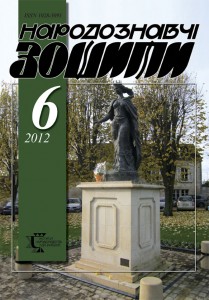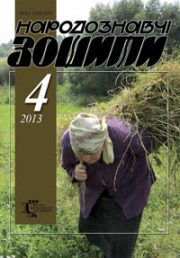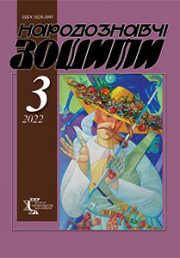
Content
Dyakiv Volodymyr. On specific features of ukrainians’ folk religiousness under conditios of bolshevist occupation at 1930s. P. 975-994
The article brings research-work in specificity of development of Ukrainians’ folk religiosity under conditions of Bolshevist occupation at 1930s. Some peculiar transformations of religious element in Ukrainians’ calendary and familial ritualism, in perception of everyday details of Soviet reality as well as events of 1930s — terror, collectivization, famines by folk consciousness have been traced in the study. Traditional in their basement those specific manifestatios of folk religiousness at the same time add new, especial motives, subjects, images and other ethnocultural components in accordance with then-a-day socio-historical situation.
Keywords: folk religiousness, miracle, rite, religious movement, spiritual creativeness.
read »
Tarnavskyi Roman. On the custom of toloka neighbouring help during constructive works in ukrainian peasants’ social life (second half XIX — first half XX cc.). P. 995-1009
The article has brought some data on the custom of toloka during the building process as a form of mutual help in Ukrainian traditional peasant society. The author has used yet unknown materials of ethnographic field expeditions, archival sourcess and research literature. He has exposed quite objective generalized characteristics for working and ritual stages of toloka custom in Ukraine. Slavonic background, with emphasis on the specificity of building technology on different Ukrainian ethnic territories has been presented.
Keywords: toloka, mutual help, building process, social life, Ukrainian peasant society, clay-straw bricks, saman.
read »
Holyk Roman. A townsman and his town: day-by-day life and ethnocultural stereotypes by lviv townsfolk in the XVII c. (exemplified by Lviv Chronicle). P. 1010-1018
The article presents analytic study on concepts of early modern Lviv in the consciousness of its inhabitants. Owing to the cases noted at the Lviv chronicle a research-work on Leopolitans’ views of urban space and time, military conflicts and ethnocultural identities of townsfolk’s communities has been exposed.
Keywords: Lviv, Lviv chronicle, urban culture, mentality, ethnocultural stereotyps.
read »
Hlushko Mykhailo. Unknown Andrii Veretelnyk. P. 1019-1026
In the article have been considered some unknown pages of the life course and creative works by Andrii Veretelnyk — ethnographer, folklorist, prose author, playwright, publicist and editor. Especial attention has been paid to his co-operation with Shevchenko Scientific Society, Lviv. In particular, analytical research-work has been made as for and the light thrown upon the subject of Veretelnyk’s ethnographic interests and his publications of folklore materials gathered in territories of the present-day Kamyanka-Buska district, Lviv region in the «Etnohraphichnyy zbirnyk»,
Keywords: Andrii Veretelnyk, life and creativwork, prosaic heritage, ethnographic and folklore activity, the Shevchenko Scientific Society at Lviv.
read »
Tarasiuk Iryna. The concept of hope in the ukrainian folk-religious spirituality: after material of paremies. P. 1027-1042
The article has brought an attempt of research-work in deep meaning of hope as a category of Ukrainians’ folk-religious spirituality as well as some peculiarities in thinking of a religious person. On the materials of proverbs and sayings being an expression of hope in God’s kindness and mercy, and sincere trust in His future blessings and help at the time of hardship the author has analyzed some folk interpretation of hope as a religious concept.
Keywords: religious consciousness, Ukrainian mentality, religious beliefs, national outlook, traditional spirituality, trust in God, notion of hope, fear, desperation, spiritual poorness, God’s blessing, mercy, national wisdom, paremy, saying.
read »
Holovata Larysa. Cultural and Scientific Publishing house of Ukrainian National Association in Protectorate of Czechia and Moravia, 1941–1944: creation to liquidation. P. 1043-1053
In the article written on the basis of new archival sources has been studied a short institutional history of Cultural and Scientific Publishing house of Ukrainian National Association at Prague. In research-work have been considered data concerning personal cast, interrelations with censorship, editorial goals, specificity in the contents of publishing tasks in the period of World War II.
Keywords: World War II, Protectorate of Czechia and Moravia, culture, communal centres, Ukrainian publishing movement, censorship.
read »
Kozakevych Olena. Lviv as a centre of knitting production (after the sources of late XIX and first third XX cc.). P. 1054-1069
In the article has been considered one of the leading centres in knitting industry of Eastern Galicia at the late XIX to the first third XX cc., i.e. the town of Lviv. The important stages in local development of knitting in the context of sociocultural factors and phenomena of mentioned period have been determined with review of general types in production; the meaning of professional education in the growth of local knitting craft has been traced. The assortment and peculiarities of artistic styling of knitting ware have been characterized.
Keywords: knitting, fabrics, studio, manufactory, ateliers, professional education, machinery, vogue, assortment, tradition.
read »
Nykorak Olena. On original features in decore of zapaska-aprons at the Western Podilia: types and centres. P. 1070-1086
The article has brought analytic study in originality of artistic features of Western Podilian zapaska-aprons classified after the techniques of weaving, compositional schemes and colouring. Productive centres and spreading of various types of zapaska-aprons have been defined. Some parallels with similar products of other historio-ethnographic Ukrainian regions as well as of neighbouring nations have been traced.
Keywords: zapaska-aprons, techniques of weaving, centres, schemes of composition, ornamental motifs, rhythmics, rapport, colouring.
read »
Taras Victoria. On historical sources in the origin of park. P. 1087-1111
In the article have been presented some historical sources and religious principles in the origin, formation and development of parks. The process of transformations of park from one of the most important means for representative, evidential representation of a ruler’s power to quite significant element in the whole urban system of verdure and recreation has been exposed.
Keywords: park, hunting, religious notions, tree of life, paradise, Elysium, animals, bestiary, Mesopotamia, Assyria, Egypt, Persia, Greece, Rome, Byzantium, Middle Ages.
read »
Fedorchuk Olena. Artistic beadwork in national art of Berezhany district (based on art criticism expedition materials of 2011). P. 1112-1122
This article is dedicated to artistic monuments of early and middle XX century, discovered in Berezhany district of Ternopil region during the art criticism expedition of the Ethnological Institute of the National Academy of Science of Ukraine. These contained superimposed beadwork adornments and national garments components, decorated with beads. The ecclesiastical artistic works (1930, 1960) revealed in the old and new churches of Zhukiv village in Berezhany district, Ternopil region, became the unique findings of the expedition.
Keywords: beadwork, glass rods, «lelitkas» scents, «herdan» beadwork necklace, apron.
read »
Makovetska Marta. On the origin and development of design art in Galicia (coverage in scientific sources). P. 1123-1131
In the article some light has been thrown upon the state of research-works presented by scientific art-scholarship literature as for preconditions for appearance of design art in Lviv as well as in Galicia as a whole. On the basis of literature and archival sources the specificity in building-up of such branches as architectural, industrial designing etc. has been discovered. Main attention has been paid to the most significant events with all-European echo and importance for development of design in Galicia and the whole of Ukraine.
Keywords: design, crafts, industry, Galicia.
read »
Hodovanska Oksana. The ukrainian diaspora in Hungary: challenges of XXI c. P. 1132-1138
The start of Ukrainians’ active social activity goes back to 1991. The Ukrainians of Hungary still are facing quite urgent necessity to overcome the movement of political rusynism, to create the Ukrainian schools as well as native University and theatre, to introduce weekly religious services in their temples.
Keywords: Ukrainians of Hungary, native school, national and cultural values.
read »
Movna Marianna. I.Krypyakevych’ guidebook on historical promenades along Lviv is 80 years with its readers. P. 1139-1145
The article brings short look on predispositions for writing of the book with special attention to its structure and factual contents; an attempt has been made to comprehend the place of guidebook in public and historical context of 1930s and that of nowadays.
Keywords: I. Krypiakevych, Lviv, guidebook, history.
read »
Smolar Olena. On unordinary character of neo-modern styling in creation of designers’ interior objects of Ukraine at the XXI c. P. 1146-1151
In the article some light has been thrown upon unordinary character of neo-modern styling in creation of designers’ interior objects of Ukraine at the XXI c.
Keywords: neo-modern styling, interior design, colour solution, composition, plasticity of forms, art of present-day.
read »
Taras Yaroslav. On architectural and decorative solution of roofs in Moldova. P. 1152-1170
In the article have been considered roofs of Moldovan huts and architectural as well as decorative solution of those. Especial attention has been paid to decorative solution of roof components, as ridge planks, chimneys, gablets, bases etc. Symbolism in compositions of gablets has been reviewed. Materials are subsequently accompanied with graphical attachments.
Keywords: Moldova, roof, gablet, décor in architecture.
read »
Pashuk Volodymyr. The Prosvita society’s first editions on the socio-economic and housekeeping themes in 1869 to 1874. P. 1171-1186
The paper has brought some characteristics of first editions on themes of social economy as well as household works and farming issued by Prosvita Society and published in various almanacs and separate prints at the period of 1869 to 1874. These had contained certain recommendations (general data of agronomy and veterinary) as for efficient agricultural management and better care of the domestic animals). To prevent the bankruptcies of farm economies popularization had been lead of some means for strengthening of peasants’ financial situation through the establishingt of public granaries and pawnshops, being well-known and effective forms of cooperation. At the same time, there had been spread some calls for fighting people’s negative features, as inebriety, laziness, ignorance, extravagance on the one hand, and cultivating temperance, diligence, thrift and establishing schools with native language education on the other.
Keywords: the Prosvita Society, enlightenment publications on the socio-economic and agricultural themes, father St. Kachala, I. Bichay, father I. Naumovych, R. Yunovych.
read »
Lesiv Andrii. Judas Iscariot in the Last Supper icon of XVIII c. from the village of Solina. P. 1187-1194
In the article has been studied the image of Judas Iscariot in the Last Supper icon of XVIII c. from the village of Solina, now an artifact in collection of the Museum of Folk Architecture at Sanok, Poland. Detailed analytical research-work in composition of icon has been performed according to principal points of art scholarship. Especial attention has been paid to a broadened examination of Judas Iscariot’s unique image, its symbolism of colours as well as Judas’ gestures and appearance. Treatment of Judas’ image as a traitor in the sacral art of Western Ukraine has been forwarded.
Keywords: Judas Iscariot, the Last Supper, icon painting, iconography, symbolism, treason.
read »
Gay Kateryna. Art market in Ukraine from the end of the XXth till the beginning of the XXIst: sources of research. P. 1195-1201
In the article have been analyzed some scientific papers and monographs considering definition of art market, its structuration and reviews of all its components. The study has brought thorough investigation in main conceptions of art marketing and its development considering it as a phenomenon of contemporary culture according to Ukrainian, Russian, American and British publications. The art market has been determined by means of exemplified fragmentary studies as a phenomenon that still is in need of interdisciplinary approaches.
Keywords: art market, conceptions of development, contemporary culture, theoretical research-work, interdisciplinary study.
read »
Sokil Vasyl. On some images of famine narratives. P. 1202-1208
The article has dealt with formation of an image. There are considered personal images as well as images of things, visual, smelling and tactile images typical for narratives on Famine diaster. Under analytic study have been put an narrator’s emotional states at his creation of the image.
Keywords: famine narratives, creation on images, images of things, visual
images, smelling images, tactile images.
read »
Mykhailuk Nataliya. On historio-artistic peculiarities of the Holy Virgin Hodegetria icon in Lviv sisterhood monastery of the Order of St. Basil the Great (hypotheses and facts). P. 1209-1217
On the basis of X-ray examination of images of Holy Virgin Hodegetria monastery icon and photographs of two other Holy Virgin icons the hand of the same painter has been traced. One of mentioned icons, that from town of Busk near Lviv has recently been introduced into scientific circulation. Another one known as the Holy Virgin Ripnivska with prophets, written by the icon-painter Fedor had been destroyed by fire. Nevertheless, photographs of this last icon have survived. Comparative studies in monastery icon and those from the St. George Cathedral, Lviv has enabled the assumption that monastery icon of the Virgin Hodegetria had belonged to the iconostasis of St. George Cathedral. On the ground of above mentioned research-work as for icon images we hereby move a hypothesis that as author of lost Ripnivska icon might be considered historically know craftsman Fed’ko who had painted the icons for St. George Cathedral.
Keywords: icon of Holy Virgin Hodegetria, sisterhood monastery of Order of St. Basil the Great, iconograpy, stylistics, iconoistasis, Lviv region.
read »
Voloshyn Mariana. Olena Kulchytska’s becoming a personality and formation of world-view. P. 1218-1228
The article deals with some problems in personal and creative formation of Olena Kulchytska, the only Galician lady-artist known to a broader audience. In the study have been analyzed certain factors and aspects of reality that influenced artist’s world outlook and the development of her personality as an artist and art critic.
Keywords: Olena Kulchytska, Viennese School, Convent of Sacraments-keepers , modern art, Viennese Secession, world-outlook.
read »
Harchuk Khrystyna. On formative period of Stryj cemetery in Lviv (at the second part XVII to the late XIX cc.). P. 1229-1234
The article has brought chronologically arranged study in the process of formation of Lviv urban Stryj cemetery from its foundation at the second half XVII till the closure. The cemetery is an unsaved monument of historical, memorial and cultural heritage of Western Ukraine
Keywords: cemetery, necropolis, burial, historical and cultural heritage, monument of history.
read »
Mróz Lech, Pavluk Stepan. Problems, reflexions, doubts (discussions on saving of non-material cultural heritage). P. 1235-1250
read »
Pechenyuk Tamila. To an object of structural systematization of artistic decorative-applied creations. P. 1251-1256
read »
Kuzmenko Oksana. On voice of time in the scripts of intellectual dialogue. P. 1257-1260
read »
Helytovych Maria. The phenomenon of Iwan Trush. New observations. P. 1261-1263
read »
Kuzmenko Oksana. «I was born in Lviv and grown up in Lviv…». First monographic research-work in Ukrainian urban folklore. P. 1264-1269
read »
Yatsiv Roman. On chefs-d’oeuvres of Ukrainian Baroque art in Louvre. P. 1270-1271
read »







